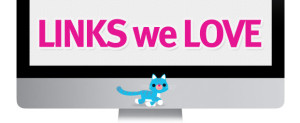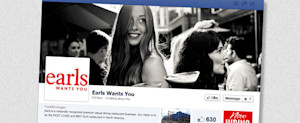I remember going to Earls restaurant when I was a kid — it was awesome. Back then, there were two huge, brightly colored parrots perched astride the entrance, and a train that circled around overhead while you ate your burger.
It’s still an awesome restaurant, but it’s nothing like the one I visited as a kid.
Not only does the award-winning restaurant chain now have 60 plus locations across the US and Canada, but Earls has gone through a major branding pivot that has taken the restaurant from brightly colored parrots to exposed brick gorgeous.
Their re-brand is one of the best I’ve ever seen, and they didn’t just stop at their marketing, menu, and interior design.
Earls has embraced social recruiting wholeheartedly, with a well-designed Facebook Career Page, professional recruiting videos, and an extremely effective Facebook Ads campaign.
This recruiting video by Earls has received over 1,750 unique video plays. It is also an awesome example of effective video recruiting!
We were very lucky to get a chance to chat with Jessica Slusar, Earls’ People Solutions Specialist, about Facebook recruiting, employer branding, and what advice she would give other employers looking to get social.
To preface the interview, we’d like to first share Earls’ employer brand philosophy:
“Great guest experiences begin with great partner experiences … At Earls, our people are our most important resource in delivering irresistible food and engaging experiences that build relationships for life.
By practicing the principles of integrity, authenticity, commitment to a cause greater than oneself, and being cause in the matter, we nurture, challenge and reward talent for the benefit of the individual and Earls, People Grow Here.”
This emphasis on finding amazing employees is made apparent through the attention to detail they’ve paid to their social recruiting strategy.
Jobcast: What spurred Earls to start using social media for recruiting?
Jessica Slusar: We realized that this was, and is, quickly becoming the new reality for recruiting. Traditional job boards and career sites are no longer the most effective avenue for getting your “we are hiring” message out there. We also noticed through our research, that very few restaurant concepts have devoted a full social platform to just recruiting. What we see most is that companies are using their corporate sites and pages to push out job postings, so we felt that if we started up social platforms that were solely devoted to recruiting, that would make us stand out. Everyone is mobile and has a device or tablet that they are attached to, so what better way to get them to hear about us then on social media, because we all know that we are all on it everyday.
Jobcast: Which social recruiting sites does Earls use for recruiting?
Jessica: We use Facebook, Twitter, LinkedIn and Instagram currently.
Jobcast: Facebook is obviously a huge focus for Earls’ social recruiting. What makes Facebook recruiting so appealing?
Jessica: Facebook is nice because we have more than just 140 characters to work with. This was a big draw for us, because we have more space to tell stories. Our philosophy of “People Grow Here” (i.e. the development and career trajectory we offer at Earls) is one of many things that make us unique and we like to tell those stories with text, pictures and video.
Also, the fact that we can build photo albums (e.g. our Earls Experience Recognition Gala, US East Coast expansion plans) means we can keep people up to date on what’s going on. We know our people like to be in the loop! And what we have found, is that our fans and followers tend to engage more with visuals and familiar language. They see their friends liking it, they share it, comment etc.
Lastly, when we get into launching targeted campaigns, FB is a great tool to utilize for drilling down and reaching our target audience (who we want to reach) with each of our custom posts.
Jobcast: Have you found Facebook Ads to be an effective way to increase applications?
Jessica: Facebook ads have been an extremely effective way to bring awareness, interaction and engagement to our page. We are unique in how we recruit (for example, we don’t have candidates submit applications via a career website). Instead, we direct them to our Earls Wants You career website so they can download an application and find their nearest Earls location to apply to in person. We want to make a genuine and authentic connection with each of our partners and we feel that by meeting with them face to face we form a unique relationship from the initial interaction.
Jobcast: How has the targeted nature of Facebook Ads affected the quality of the applications you receive?
Jessica: Facebook Ads are fantastic for reaching our key partner demographic, starting from the high school grad getting their first job with no experience, to an experienced hospitality veteran looking for a change. It’s also great in challenging and emerging labor markets like Calgary and the US.
Jobcast: Were there any obstacles or roadblocks you had to overcome when transitioning from typical recruiting methods to Social and Facebook recruiting?
Jessica: What we noticed is that we couldn’t just keep doing what we had done with typical job boards. We needed to find a way to take the traditional job ad and role description and shrink it down to something cool, catchy and relevant. Now, we really think about the content we send out, making sure we add value to our followers feeds while still accomplishing our ultimate goal of getting people in the door to apply. There was a lot of trial and error, test campaigns, and strategy adjustments halfway through. Being flexible and changing it up is how we have started to see some of our successes.
Jobcast: Can you share a few of your Facebook recruiting successes?
Jessica: We found that enlisting our existing partners and leaders in spreading our messages was the first step to success. Word of mouth is a powerful message, so we got our existing partners to start Liking, sharing and talking about Earls Wants You on social, which helped articulate who we are and why we are different.
The second thing we did was research and learn from the success stories out there. We started following and talking with brands that were executing their social recruiting presence well. Imitation is the sincerest form of flattery.
Third, successful social platforms take a lot of time, so the huge win for us was partnering with a company that offered a breadth of social expertise (the Jobcast Recruiting App). Our first campaign was just a test run in Calgary and Edmonton (Alberta is a notoriously tough labor market) and we thought that if we could achieve reach, interaction, and engagement from a targeted campaign in challenging locations, then we could see future success in our other regions.
Jobcast: What tips can you offer other companies looking to get started with Facebook recruiting?
Jessica: Initially, do your research and start following, watching, and learning from other successful brands that do it well.
Once you’ve gotten started, establish what your brand is, what your message is, and what makes you unique and engaging to your followers. Recognizing what is valuable information for your followers is critical for brand perception and long-term engagement. You want to offer value to every potential partner.
Jobcast: Earls has an amazing brand on and off-line. How did you manage to transition your brick and mortar branding to Facebook so well?
Jessica: For Earls, we are genuine and authentic in our relationships. How we show up in person is how we should show up online. So we took our Earls Experience, Partner values, mission and vision, how every partner and leader in the entire company functions every day, and brought it online. We wanted to show a glimpse of what they can expect to see when they walk into our restaurant. By telling stories, sharing partner profiles, images, videos and the passion for what we do it adds that level of personal connection for our followers, fans, alumni and potential candidates.
Jobcast: What does Facebook offer your brand that other mediums don’t?
Jessica: The great thing about social media and FB is that we can reach candidates all the time. Unlike traditional job boards that are successful for the active candidate that is pursuing the search, social media helps to reach that passive candidate in a subtle, non-invasive way. By posting great stories, pics, videos and job information, we splash across candidate’s news feeds as many times as they check their phone. It’s proactive vs. reactive.
Jobcast: What advice would you have for other companies looking to improve their Facebook employer branding?
Jessica: Don’t just push out job openings… it’s boring. Engage with your followers and fans, build relationships — that’s what social media is all about. Stay fun, fresh, cool and relevant. Always keep learning and evolving your strategy.
Jobcast: What makes Earls a great place to work? What should potential employees know about the Earls’ company culture?
Jessica:
People Grow Here, you will see this in a lot of our posts and it’s true. We can take someone with very little, to no experience, and provide them with all the training and tools they need to become successful in whichever role they are in. There are so many great examples across our company of partners who have started as hostesses and dishwashers and are now President and GM and Chef.
We have Soul — as I have mentioned before, we are all about genuine and authentic connections and building lifelong relationships, with each other, our partners and our guests.
Your opportunity is limitless — there are so many exciting things happening with Earls right now and the sky is the limit for our people. We are expanding to new markets in the US, so there are so many opportunities for movement and growth and development.
We have passion for what we do and why we do it — we deliver irresistible food and drink, and engaging experiences, and have a whole lot of fun while we do it.
Jobcast: Company culture is a huge part of the Earls brand. Could you share some tips for other employers looking to show off their company culture on Facebook?
Jessica: Be real, be authentic and engaging. Don’t try to be something that you aren’t.
We couldn’t sum up the essence of Earls’ employer brand any better ourselves… that’s why Jessica is the specialist! We want to thank Jessica Slusar and Earls for answering all of our questions and being such a great company to work with.
For some incredible Facebook recruiting inspiration, check out the Earls Wants You Facebook Career Page — it’s truly fantastic. And don’t forget to check out how the Jobcast Enterprise plan can take your Facebook recruiting to the next level.









